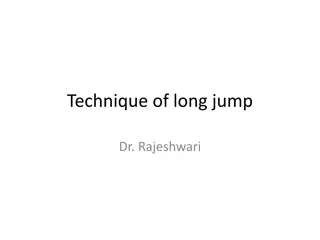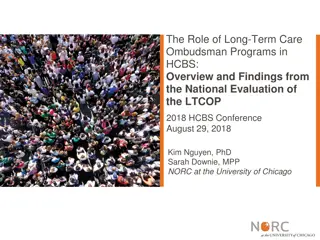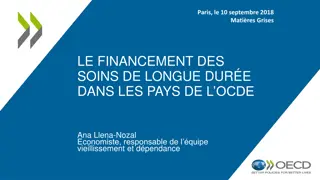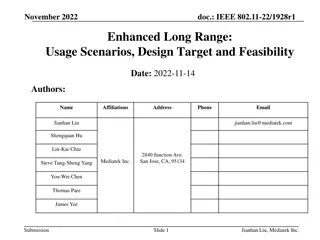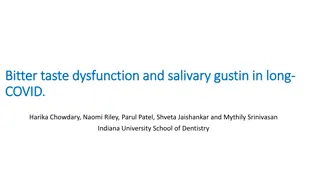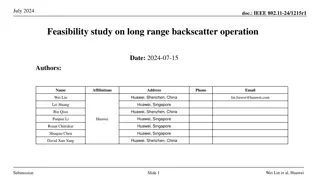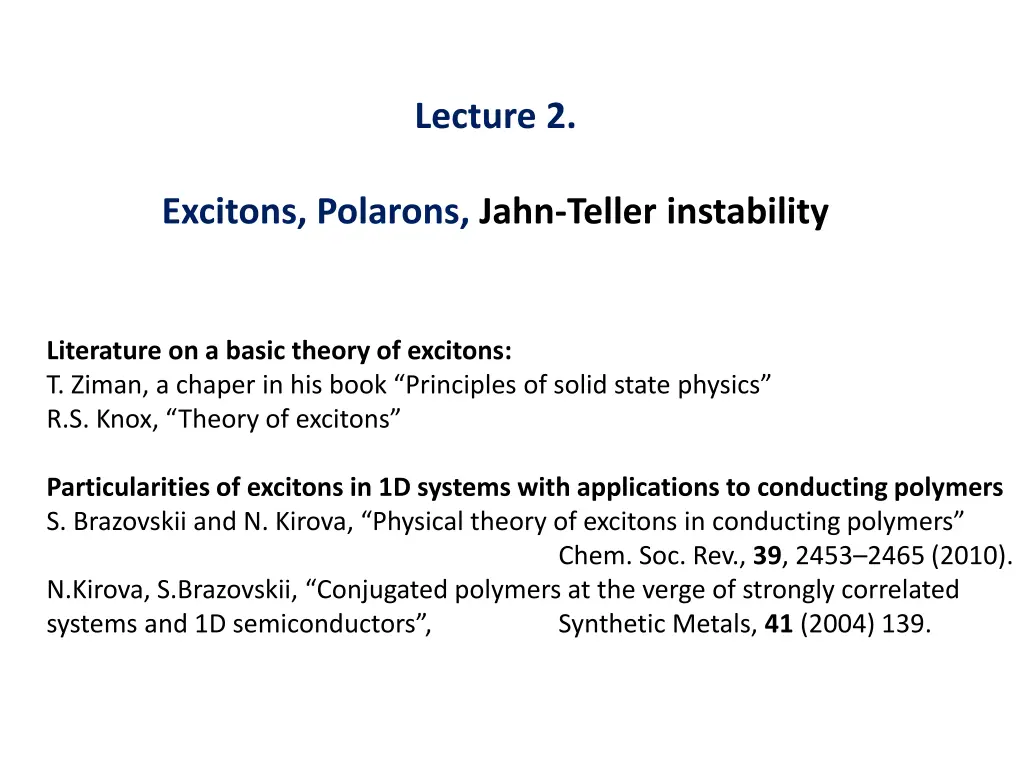
Understanding Excitons, Polarons, and Nonlinear Optics in Conducting Polymers
Explore the fundamental aspects of excitons, polarons, and Jahn-Teller instability in conducting polymers. Learn about the theories of excitons, optical polymers, and nonlinear optics, including tools for studying these optically active excitations. Discover how linear and nonlinear optics can be used to observe absorption spectra, emission processes, and time-resolved dynamics in these systems.
Download Presentation

Please find below an Image/Link to download the presentation.
The content on the website is provided AS IS for your information and personal use only. It may not be sold, licensed, or shared on other websites without obtaining consent from the author. If you encounter any issues during the download, it is possible that the publisher has removed the file from their server.
You are allowed to download the files provided on this website for personal or commercial use, subject to the condition that they are used lawfully. All files are the property of their respective owners.
The content on the website is provided AS IS for your information and personal use only. It may not be sold, licensed, or shared on other websites without obtaining consent from the author.
E N D
Presentation Transcript
Lecture 2. Excitons, Polarons, Jahn-Teller instability Literature on a basic theory of excitons: T. Ziman, a chaper in his book Principles of solid state physics R.S. Knox, Theory of excitons Particularities of excitons in 1D systems with applications to conducting polymers S. Brazovskii and N. Kirova, Physical theory of excitons in conducting polymers Chem. Soc. Rev., 39, 2453 2465 (2010). N.Kirova, S.Brazovskii, Conjugated polymers at the verge of strongly correlated systems and 1D semiconductors , Synthetic Metals, 41 (2004) 139.
Flexible solar cells h A Flexible, printed plastic solar cell with high efficiency made by SIMENS AG Physics of various optically active excitations, their mutual transformations, dynamics and kinetics, constitute the most important fundamental and R&D science. 2
Optically active polymers Poly-vinyle-phenylene PPV Poly-phenylene PPP Poly-theophene or Poly-pyrolle Add more examples From the files?? =S or N 3
Linear and non linear (still at low power) optics Linear optics (LO): Observe the absorption spectra, reflectivity PL Pump Nonlinear optics (NLO): pump probe expr. Photoinduced absorption (PA) Pump - Light 1 : fixed energy across the gap E>Eg, creation of the excited states Probe Light 2: test excitations of the earlier excited states by scanning the probe light energy Stimulated emission (SE) Pumpe - Light 1 : fixed energy across the gap E>Eg, creation of the excited states Probe Light 2: provokes recombination of the excited states with the emission of the optical photons. PA Pump SE Time resolved NLO: Measurements as a function of time delay between pump and probe. 5
Which tools do we dispose? What kind of feature can we study? Linear optics: 1. Absorption gives the spectrum of virgin excitations. 2. Emission gives the spectrum of reconstructed excitations (polarons). 3. Time resolved emission allows to watch the reconstruction in real time. Nonlinear Optics. 1. Stimulated emission SE. A small probe illumination provokes emission from earlier pumped excitations at the probe frequency. Einstein principle (from Bose statistics of photons:) the SE of even one photon ~ number of photons at this energy. 2. Photoinduced absorption PA. The basic excitation E1 may possess higher excited states En. Hence optical transitions from E1 to E2, etc. These allowed transitions help to identify the exciton, also they give access to states which are not accessible directly: by the odd/even symmetry allowed E0-E1+allowed E1-E2 = not allowed E0-E2 3. Photoconductivity under (stationary) or after (transient) pumping: gives access to higher energy E>Eg>Eex unbound excitations free e-h pairs. Also to excitons with their subsequent ionization by thermal activation or applied electric field E. 6
Combined methods. 1. High frequency photoconductivity in combination with optical and teraHerz studies - In this lab. 2. Optical experiments within the setup of the ESR electron spin resonance. To distinguish spin-dependent effects. Solar energy harvesting needs absorption of light (exciton e + h) LED needs emission of light (e + h excitons) Major issues in design, understanding and improving of materials: free e-h pair versus excitons Singlet exciton versus triplet ones On-chain versus interchain binding 7
Optical absorption spectra of (CH)x and PPV A1 SE A2 1.0 A3 PA1 PA2 0.5 (normalized) A4 0.0 O -0.5 O -1.0 MEH-DSB 0 1 2 3 4 5 6 Photon energy (eV) 650 ps 2 0.1 6 5 4 3 d 2 SE (2.43 eV) 0.01 6 PA2 (1.46 eV) 5 4 3 = 630 ps 2 0.001 0 100 200 300 400 500 600 8 Delay time (ps) Utah 1997-2002
Special problem of losses: 1. Recombination of excited states without emitting a photon: It needs a staircase of levels to descend down loosing the energy of ~2eV by emitting a sequence of phonons each at <0.2eV. Impurities or stronger the surface or an interface. 2. Falling to the lower energy non-radiative excitations: a. Lowest exciton is indirect one, with the momentum Pex 0: Special: Energy minima for the electron and the hole lye at different points of the Brilloin zone: like in Si but unlike GaAs. b. General and inevitable: Formation of triplet excitons TE which energy is always lower than for singlet ones. Also for the LED: with electrons and holes meeting randomly, the probability of meeting in a triplet state (3 combinations of the total spin quantum m=1,0,-1) is 3 times higher than for the singlet state s=0. TEs live for very long, diffuse distantly, and have a high probability to reach the areas of intensive non-radiative recombination. 9
Singlet and triplet excitons: creation and annihilation E E Optical pumping Charge injection Singlet Triplet ps ms s Luminescence, primary singlet Phosphorescence Fluorescence, singlets trapped by the impurities Nonradiative decay channel Interfaces, lattice vibrations 10
Geminite (twin) excitation crerated by one photon 1. The total momentum is zero: Pexciton=Plight=Eexiton/c light velocity c is 100-1000 times higher than the typical one of electrons. 0 - 2. The spin is always zero the singlet excitation: the light has an orbital momentum, but it interacts except via its weak ~1/c magnetic field only with the orbital motion of electrons, hence cannot change their spin. 12
Non-geminate excitations They are formed in light emitting diodes (LED), or under intensive pumping Can have any orbital angular momentum Can have total spin s=0 or spin s=1 Triplet exciton: 4 e 2 1 1 1 ~ Eb ~ R = + 2 2 2 e * e * h m m 13
From excitations to free carriers and excitons Features from kAg, mAg, nBucomputed for small systems, as states with quasi-momenta k (Ag~ sin kx, Bu~ cos kx) they will form continuous bands. Structureles band LUMO Split-off exciton HOMO Part of these transitions (non-diagonal in k) will be forbidden by the momentum conservation law, which does not act in small systems. 14
Excitations or excitons ? In solid state physics : Exciton is always an undividable neutral state a bound state of the electron and the hole in language of the semiconductors science. Optical excitation is a more general term extended to higher excited states when there is enough energy for the electron and the hole to separate infinitely. The difference is commonly ignored in language of the molecular science: No difference in small systems the objects of the molecular science. The only distinction: Intra-molecular (Frenkel in SSPh) or extended intermolecular Charge Transfer Exciton CTE (Wannier-Mott exciton in SSPh) 15
EXCITON : electron-hole pair, bound by long range Coulomb forces Compare the atom or the positronium Important question what kind of particles are created by light and evolve: band electrons and holes, or excitons? Excitons give rise to the photolumunescence Band electrons and holes give rise to the photoconductivity E 16
Long range Coulomb interactions and exciton A picture for molecular crystals Negligible band width. Coordinate is an allowed quantum number Free electron and hole stay at molecular sites at a a distance R E LUMO HOMO Charge transfer exciton Coulomb bound e-h pair Eex= Ee+Eh-e2/ Rex<Eg 17
Intramolecular overlaps, Wide bands Long range Coulomb interactions and exciton Eg=2 2 p = + E Free electron and hole , e h * e 2 m Ee+Eh=Eg , h conduction band Exciton level Eg EF k valence band Optical transitions: band - to band : E=Eg Free e, h photoconductivity exciton : E=Eex <Eg photoluminescence Exciton - Coulomb bound e-h pair 18
1D excitons in solid state physics p x W - band width Wannier-Mott exciton: large bands W small energy Eb<< Eglarge R - basis of the states near the band edge. Kohn-Luttinger effective mass approach. E<<W E 2 2 e p 2 2 2 e R a = + = + E ln E 2 b b 2 R mR x m k 4 2 m e * 2 R a R a 1 = b= ln R 2 ln E 2 m e * 2 Ln2 factor : capacitance of elongated cigars of charges Frenkel exciton: narrow bands, Eb Eg we need the states from the whole band W, small R, large p electron hole 19
Ionization of a shallow Wannier-Mott exciton by the electric field (field induced exciton dissociation) High electric field F exciton is destroyed and particles participate in photoconductivity small electric field F exiton is preseved eFRex>Eb 20
Band edge Exciton x 1 x 13.8 x 24.3 Iphoto (a.u.) x 61.5 4x105 V/cm x 277 1.6x105 V/cm 5 pristine after 2h exposure Iphoto (a.u.) 4 1.2x105 V/cm 3 0.8x105 V/cm 2 1 0.4x105 V/cm 2.2 2.4 2.6 2.8 3 3.2 2 2.2 2.4 2.6 2.8 3 3.2 Energy (eV) 3 1 * E E m 4 2 2 = b b exp 3 e F D. Moses, A.J. Heeger, S.B., N.Kirova., 2000 Problem 1: singlet excton estimated energy is too small, <0.1eV Problem 2: triplet exciton binding energy ~0.7-0.9 eV is too high Resolution: electronic correlations 21
EELS method- electron energy loss spectroscopy. Access to the exciton s momentum (unlike P=0 only in optics). Proof for coexistance of localized and mobile excitons. High energy electrons passes through the crystal The output energy E` and momentum p` determine the losses inside the crystal, hence the energy of emitted elementary excitations (excitons) E`(p`)-E(p) = Eex(p`-p) e: E`,p` e: E,p exciton Localized and delocalized singlet excitons M. Knupfer et al, Germany (1998) 22
Non-geminate excitons They are formed in light emitting diodes (LED), or under intensive pumping E Electron in conducting band meets a hole in valence band The two can form a hydrogen-like bound state. Exciton! Can have any orbital angular momentum Can have total spin s=0 or spin s=1 Ratio of TE/SE=3/1 23
Singlet -Triplet One electron in magnetic field: Zeeman splitting in two levels s= 1/2 Two electrons in magnetic field: ( ) 1 = | | s S=0 Singlet state no splitting 2 S=| > = 2 ( ) 1 | + | s S=1 Triplet state S=| > ( ) 1 | | Gain of the exchange energy 2 ( ) 1 | + | Gain of the kinetic energy 2 24
Compatibility of spins and coordinates for Fermions: S=0 only symmetric (x1,x2) kinetic energy gain S=1 only antisymmetric (x1,x2) exchange energy energy gain S-T splitting (exchange energy) 2 e = = + ) ) ( , ) ; 2 1 2 2 U x y ( ( ( ) H E dx dx U x x x x x y 1 2 1 2 1 2 kin ) ) ) ) ( ( ( ( ( ) dx dx U x x x x x x 1 2 1 2 1 1 2 1 2 1 2 2 2 2 2 e a 3 e ~ E E S T R R Es Eg ET N.B. Energy decrease of triplet state for repulsive electrons. This is a background for: Hund rule in atoms, ferromagnetism, some cases of triplet superconductivity in organic metals For us: the sunk of light emitting singlet excitons to the long leaving triplet ones 25
Intra-molecular electronic correlations: Benzene ring, optical transitions In reality gg*-uu* gu*+ug* 6.76 eV Calculated without Coulomb correlations gg*+uu* 5.96 eV T 0 -T gu*-ug* 4.71 eV Triplets : 4.71 eV 3.59 eV, 4.8 eV T 0 -T 26
Polymer Isolated benzene ring 1E1u gu*+ug* gg*-uu* LL* 6.76 eV 6eV DD* DL* LD* 1B1u gg*+uu* 5.96eV 1B2ugu*-ug* 4.71eV 2.4 3eV Delocalization breaks the intra ring scheme ! The g-states most favoable for the band delocalization contribute to the highest intramolecular states (~4eV difference) Lowest intamolecular state involves u-states, which do not benefit of delocalization (2-3 eV). 27
Long range Coulomb attraction and intra-monomer repulsion for e-h pair. h e Classical visualization: e-h pair moves towards each other accelerating by Coulomb attraction. Instead of free passing like in a Wannier - Mott exciton, they face a wall of onsite repulsion. The impact interaction is equivalent to adding the central repulsion peak potential U0, the particles must tunnel through. 29
Electronic correlations Electronic correlations : role of : role of the impact interaction U the impact interaction U0 0 2 4 U m*e 2 2 R a a a 2E B = E ln 0 Bu 2 0 U0 between quantum states of free band particles (e,h) and exact correlated molecular It differs for various excitons. US-UT - effective exchange interaction depends on overlap Bu -singlet Triplet intra- states. x a Interaction potential US>>UT 30
Exciton wave functions for various intra-monomer repulsion potentials =2.5 U=1eV U=0 U=4eV 31
The fundamental edge Eg : free particles, photoconductivity threshols DOS 1/ (E-Eg) (CH)x CDW 32
Donor-acceptor chains - workshop for pumping of excitons Intra-molecular excitons IME (S. Koshihara) Inter-molecular = charge-transfer excitons CTE (H. Okamoto). CTE, 0.6 eV IME, 2.4 eV CTE: All signature of the unbound e-h excitation, Not the exciton
Optical absorption, long rang Coulomb effects absorption absorption E E Short range Coulomb interactions Long range Coulomb interactions 34
Unbound pairs: suppression of the light emission by the long range Coulomb attraction Classical intuition: attraction keeps e and h together, thus enhancing their recombination (emission probability) But : attraction accelerates the velocities and particles pass by without hand shaking e h e h 3 a ma 2 e = = = ( ) 2 v x 2 * 2 2 ( ) 2 v a e m v e * ( ) m x = 0 T 2 x * 2 * m v a m = = Without Coulomb interactio n : E E g rec 2 E E g * 2 2 * m v e a m + = = With Coulomb interactio n : E E g rec 2 a 2 + / E E e a g T ~ / T<10-1 T 2 / e a T~10-100K, e2/a~10eV 35
Towards the quantum picture of the final state interaction Wave function of the relative e-h motion x=xe-xh 1 ~ x x v 1 ~ x x v + cos ( ) even ( ) 2 e = just like in classics ( ) 2 v x * m x sin ( ) odd ( ) x x 1 dx ( = = 2 ( ) mv x dx de Broigle wavw length ) x a 0 0 2 ~ ( ) ~ P a x a + ( ) v a | +(0)|2- probability of recombination -(0)=0, no recombination, no classical analogy 36
Jan-Teller instability. Moleculs, Fullerenes, Conducting polymers. A Route to the Peierls effect 37
The Jahn-Teller effect Jahn-Teller theorem: there cannot be unequal occupation of orbitals with identical energy Molecules will distort to eliminate the degeneracy a nonlinear symmetrical molecule with a partially filled set of degenerate orbitals will be unstable with respect to distortion and thus it will distort to lift a degeneracy to a lower-symmetry geometry and thereby remove the electronic degeneracy The case of self trapping extended version of Jahn-Teller effect. Lattice deformations create a dip in the potential energy U of the electron. Common in transition metal complexes, manganites etc, where d or f orbitals are partially filled. Requested at coming of fullerenes 38
Cyclobutane C4H4 Jahn-Teller effect 4 carbon atoms 4 -electrons Wave functions: 1=cos 0 n=cnst 2=cos( n/2) 3=sin( n/2) 4=cos n=(-1)n Half filled doubly degenerate level Instability square --> rectangle 39
Isolated benzene ring H H C C H C C H C C H H Degenerate level is completely filled no gain from reducing the hexagon symmetry. We only loose the deformation energy N=8 again the instability, like for N=4, what is next, and at large N ? 40
Fullerene Fullerene (C60) Crystal Cage diameter - 0.71 nm Optical gap 1.9 eV Crystalline Fullerene fcc structure with lattice energy [ ] -2 -1 t1uLUMO can adopt up to 6 electrons t1u LUMO 0 1 HOMO hu 2 3 41
+ 60 n nC A Charge transfer crystals : n=0, dielectrics n=1, metal at high temperature quasi 1D polymeric chain at room temperature quenched dimer lattice at low temperature. n=2 1/3 filled band, should be a metal, but is a semiconductor n=3 half filled band metal, superconductor n=4 2/3 filled band, should be a metal; but is a semiconductor, semimetal under pressure, bct n=5 does not exist ? n=6 completely filled t1u, dielectric 1D polymeric phase under illumination, 2D polymeric phase under pressure 42
C n The Jahn-Teller effect on the isolated molecule 60 Uniaxial cage distortion: Splitting of the t1ulevel Rem.: Center of gravity of the levels does not change Two-fold degenerate (x,y) level E1=- /3 Non degenerate z-level E2= 2 /3 2 3 2 2 K 2 K n n 3 = + + = + 2 ( ) 1 2 W E E n E n E 2 1 1 1 2 2 2 W n 3 n 3 = + = 0 0 1 2 K 0 E2,n2 3 2 n n = + = 1 2 n n n 2 /3 0 1 2 K - /3 ( ) 2 1 2 n n E1,n1 = 2 W 18 K 43
4 C Excited states of the molecule, 60 anti Jahn-Teller effect /4 /2 E E 1 2 ex ex 2 Triplet excited state 1 Triplet excited state 2 = E 0 0 3 5 E = E = 0 Eex Eex 1 0 0 2 0 8 2 Ground state Excited state 44
Electrons on deformable lattice - instabilities Interaction between two different single-electron centers 1 2 If there were no overlap t : E1=E0; E2=-E0 E0 -E0 E t 0 = = + 2 0 2 H ( ) E t E t Hamiltonian for the eigenstates: t E 0 = + = + 2 0 2 2 0 2 ( ) 2 ( ) 2 E t E t E t E t Anti-bonding totally excited state - repulsion Ground state -attraction larger t First excited state: E+(-E)=0, no interaction 45
Add the potential energy: K = 2 W t pot 2 K = + + 2 0 2 2 2 E E t t total 2 If E0<<t - nearly identical atoms: 0.1 K 0.2 2 2 E t t 0.3 total 2 0.4 0.5 Always non trivial minimum at t 2/K an equilibrium 0.0 0.2 0.4 0.6 0.8 1.0 If E0>>t 0.0 2 1 E t E K K 0.5 + = + 2 2 2 2 E E t E t 0 0 total 2 2 1.0 0 0 1.5 Instability threshold at E0K=2 2.0 0.0 0.2 0.4 0.6 0.8 1.0 46
Electrons and excitons on a deformable background Self-trapping of electrons and excitons Polarons 47
www.britannica.com: Polaron. An electron accompanied by an electrical displacement of neighboring charges constitutes a polaron. What s a polaron? www.wikipedia.com : A polaron is a quasiparticle composed of an electron and its accompanying polarization field. Formation of polarons: A conduction electron in an ionic crystal or a polar semiconductor repels the negative ions and attracts the positive ions A self - induced potential arises which acts back on the electron Energy gain must exceed the cost of deformation + kinetic energy of confined electron Origin of word polaron selpftrapping in polar crystals (NaCl, LiF, etc) Today used of all types of selftrapping or autolocalization 48 Polaron effect is strong in ionic, but weak in covalent crystals except 1D systems !
1T-TaS2 polaronic Wigner crystal view (ours, disputable). Background: narrow-gap (Eg= e+ h 0.6-0.8 eV) insulator formed from parent metal (with 1e per Ta site) by a high-T (>500K) CDW. Incomplete nesting leaves each 13-th electron ungaped which in a typical CDWs would give rise to a pocket of carriers. Here, each excess carrier is self-trapped by inwards displacements of the surrounding atomic hexagon (forming the David star unit) which gives rise to the intragap local level accommodating this electron. These charged heavy polarons inevitably arrange into the Wigner crystal which is always a hexagonal super-lattice by Nature chance upon the underlying hexagonal lattice This ideal locked form is the C phase.
Exciting the self-trapped electron from the intragap level deprives the deformations from reasons of existence, the David star levels out in favor of a void in the WC while the electron is sent to a higher delocalized band or recombines with a band hole. Adding an electron to the UHB may lead to a stable bipolaron, but the energy cost most probably will not allow for its stability. Mitosis into two polarons will proceed thus creating an interstitial in the WC both voids and interstitials have been seen by STM.
l 1D polaron: self-consistent problem U Spontaneous deformation forms the potential well U for an electron Energy functional: 2 2 P KU = * 1 dx = + + * * E dx U * 2 2 m K- elasticity contant electron wave function m*- electron effective mass ~2/m*l2 ~ U ~KU2l/2 2 2 KU l E 1 Kl = + + E U = U Min over U at * 2 2 2 m l 0 1/l 2 1 Kl = E * 2 2 2 m l 2 2 K l= - a free electron, is always unstable l * m Minimum at M m U At D>1 the long range Coulomb interactions are necessary p * polaron = e + strain field a heavy particle ph 51
Polaronic effects - lattice relaxation electron interaction (flat arrangement of phenyl rings) competes with Van der Waals hydrogene repulsion (perpendicular arrangement of phenyl rings) 4Tcos W Lattice relaxation: phenyl ring libration Torsion angle 20o for PPV and 30o for PPP 52
Polaronic effects: SE and PL Stimulated Emission red-shift 1,6 492 1,2 SE peak (nm) 494 =5.4 ps at T=80 K T (arb.un.) 496 0,8 498 0 3 6 9 12 Time (ps) 0,4 0,0 2,2 2,3 2,4 2,5 2,6 Energy (eV) Lanzanni et al, 2002 Hayes et al, (1995) 53



![Long-Range Wireless Charging Market Report & Analysis _ BIS Research [2024-2035]](/thumb/87166/long-range-wireless-charging-market-report-analysis-bis-research-2024-2035.jpg)

